|
Little Round Top
Battle of Gettysburg
Little
Round Top Battle of Gettysburg, Colonel Joshua Lawrence Chamberlain 20th Maine Infantry Regiment Volunteers, Colonel
William C. Oates 15th Alabama Infantry, Little Round Top Battle of Gettysburg Battlefield
Little Round Top and Battle of Gettysburg
Little Round Top
The second day of fighting at the Battle of Gettysburg was the largest and costliest of the three days.
The second day’s fighting (at Devil’s Den, Little Round Top, the Wheatfield, the Peach Orchard, Cemetery Ridge,
Trostle’s Farm, Culp’s Hill and Cemetery Hill) involved at least 100,000 soldiers of which roughly 20,000 were
killed, wounded, captured or missing. The second day in itself ranks as the 10th bloodiest battle of the Civil War.
| Little Round Top |
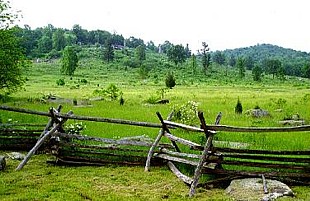
|
| Gettysburg NMP |
This rocky hill at the southern end of Cemetery Ridge is a key feature of the battlefield and one of the most heavily visited sites
in the park. Unlike the thickly wooded Big Round Top, this smaller hill had been partially cleared of trees a year or more
prior to the battle. Strewn with loose rocks and large boulders, it offered a natural position from which to defend this important
end of the Union line.
Little Round Top had been manned by Union troops as early as the night of
July 1. Yet, with the exception of a few soldiers from the Union army's Signal Corps, it remained largely unoccupied until
late on the afternoon of July 2. From their signal station on the northern summit of Little Round Top, the flag wavers held
a commanding view of the battlefield to the north and west. It was the occupants of this signal station who concerned General Longstreet as he marched his troops into position to attack the Union left that afternoon.
| Gen. Warren |

|
| Generals in Blue |
| Col. Vincent |

|
| USAMHI |
Swift action by Brigadier General Gouverneur K. Warren saved this key position.
The chief engineer on General Meade's staff, Warren had been sent by Meade to survey the left flank of the army that afternoon,
after Sickles' messages to headquarters regarding the Third Corps' position. Climbing to the summit of Little Round Top, Warren
was aghast at what he saw- General Sickles had moved his entire corps out to the Devil's Den-Peach Orchard line, leaving this key hill unprotected. It was not only a good observation
post, but a key anchor for the Union line on Cemetery Ridge.
When Southern batteries opened fire at 4 o'clock, Warren spotted Hood's Confederates as they emerged from the cover of Warfield Ridge, the direction of march toward the Round Tops. Realizing they could easily flank
the Union positions at Devil's Den and capture Little Round Top, Warren encouraged the signal men to remain at their post
and keep waving flags while an aide galloped off to find any Union troops he could locate to get them to the hill.
| Battle of Little Round Top |
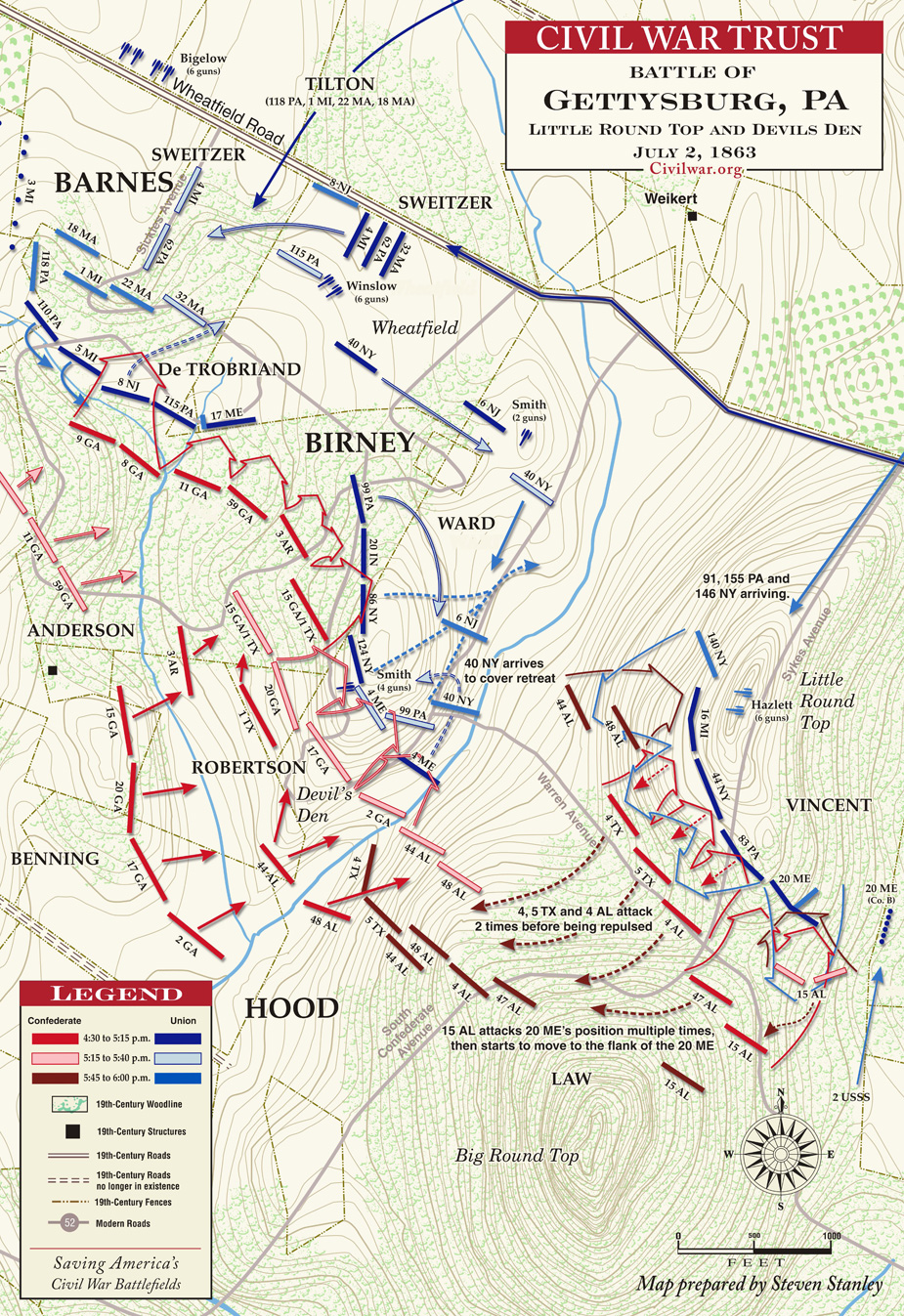
|
| Battle of Little Round Top, July 2, 1863 |
| Little Round Top, July 14, 1863 |
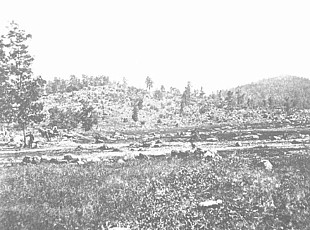
|
| (National Archives) |
Colonel Strong Vincent, in command of a brigade from the Fifth Corps, was
marching his soldiers toward the Peach Orchard when he was approached by the staff officer from General Warren. Vincent immediately
realized the desperate situation. Despite his orders to go to the aid of Sickles, Vincent turned his infantrymen southward
and led them to Little Round Top where he posted his four regiments on the rock-strewn south side of the hill. Within minutes,
two Alabama regiments of Law's brigade emerged from the tree-covered slope of Big Round Top and rushed Vincent's men.
(Right) Photo of Little Round Top less than two weeks after the Battle of Gettysburg.
Both names popularly associated with Little Round Top, Chamberlain and Oates,
would serve the United States in various capacities after the war. Joshua Chamberlain (September 8, 1828 –
February 24, 1914) would serve as Governor of Maine while William Oates (December 1, 1835 – September 9, 1910) would
serve in public office as well as the United States Army during the Spanish-American War (1898). Courtesy National Archives.
When General Law replaced General
Hood in command of the division, command of his Alabama brigade was passed to Colonel William C. Oates who's dirty, gray-clad soldiers of the 15th Alabama Infantry had marched over the summit of Big Round Top and now
poured a deadly fire into the Union ranks. Vincent's men immediately responded. The 47th Alabama regiment arrived and increased
the pressure on Vincent's line. The fight raged around the base of the hill.
| Colonel Joshua Chamberlain |

|
| Maine State Archives |
| Colonel William C. Oates |
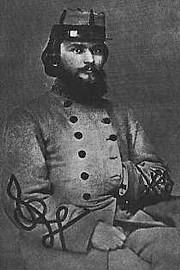
|
| Gettysburg NMP |
Oates' 15th Alabama Infantry was locked into a contest with Vincent's left
regiment, the 20th Maine Infantry commanded by Colonel Joshua L. Chamberlain. Repeated southern charges made no headway against the stubborn soldiers from
Maine who loosed volley after volley into the swarm of Confederates.
"My men obeyed and advanced about half way to the enemy's position," Colonel
Oates reported, "but the fire was so destructive that my line wavered like a man trying to walk against a strong wind, and
then, slowly, doggedly, (bend) back a little. To stand there and die was sheer folly; either to retreat or advance became
a necessity. My Lt. Col. I. B. Feagin, lost his leg; the heroic Capt. Ellison had fallen, while Capt. Brainard, one of the
bravest and best officers in the regiment, fell exclaiming: 'Oh God! That I could see my mother', and instantly expired. Lieut.
John A. Oates, my beloved brother, was pierced through with eight bullets and fell mortally wounded."
Great gaps also appeared in the ranks of the 20th Maine. Chamberlain's men were holding their own, though
the position was becoming more precarious as the frightful minutes dragged by. Then an officer spied Confederates moving toward
the regiment's left flank. "I immediately stretched my regiment to the left by taking intervals," Chamberlain wrote. "My officers
and men understood my wishes so well that this movement was executed under fire, the right wing keeping up the fire, without
giving the enemy any occasion to seize or even suspect their advantage.
| Battle of Gettysburg, July 3, 1863 |
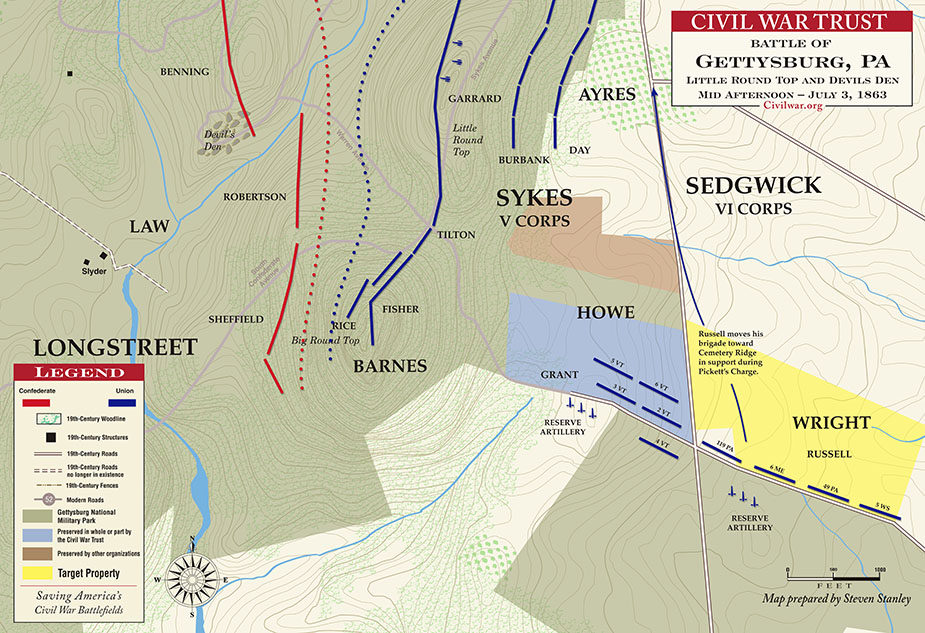
|
| Little Round Top, July 3, 1863 |
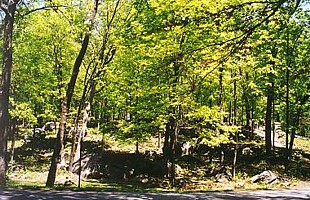
|
| Location of 20th Maine |
(Right) Position of the 20th Maine Infantry on the southern slope of Little
Round Top. Gettysburg NMP.
They renewed the assault on our whole front and for an hour the fighting
was severe. Squads of the enemy broke through our line and the fight was literally hand to hand. The edge of the fight rolled
backward and forward like a wave." Shouts for ammunition filled the air as cartridge boxes emptied. Some men had a few cartridges
left while others had none, even after rifling the boxes of the dead and wounded. Knowing that the next charge would break
his thin line, Chamberlain decided to take the initiative away from the 15th Alabama: "At that crisis I ordered the bayonet.
The word was enough. It ran like fire along the line, from man to man and rose to a shout, with which they sprang forward
upon the enemy, now not 30 yards away."
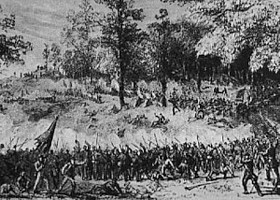
|
| 15th Alabama and the 20th Maine |
(Left) With bayonets fixed, the 20th Maine charges down Little Round Top
into the 15th Alabama. War Between the Union & Confederacy.
The hillside echoed with the distinctive metallic click of hundreds of bayonets
on rifle barrels. With a cheer, the 20th Maine rushed down the body-strewn slope. The exhausted Alabamians were caught off
guard by this audacious move and scattered. Those who ran eastward were caught in a hail of bullets from the 20th's detached
Company B, lying behind a stone wall 100 yards away. Confusion reigned as the 15th Alabama melted into the trees.
"We ran like a herd of wild cattle," Oates lamented. "On the top of the
mountain I made an attempt to halt and reform the regiment, but the men were helping the wounded and disabled comrades and
scattered in the woods among the rocks. The dead literally covered the ground, blood stood in puddles on the rocks. The ground
was soaked with the blood of as brave men as ever fell on the red field of battle." Assisted by soldiers from the adjacent
83rd Pennsylvania, Chamberlain's men rounded up 400 prisoners from the 15th and 47th Alabama regiments, including a number
of officers.
At the opposite end of Vincent's Line, the Confederate pressure was too great.
The 4th and 5th Texas Infantry Regiments pressed back the Union line. Hearing the commotion, Vincent rushed to rally his men
where he was struck by a Confederate bullet and mortally wounded while directing the defense. The injured colonel was carried
away just as reinforcements arrived.
The 140th New York Infantry led by Colonel Patrick O'Rorke, appeared on the summit of the hill. Seeing the melee below him O'Rorke turned
to his men and led them in a charge straight into the Texans. "Here they are, boys!" O'Rorke shouted, "Commence firing!" These
were his last words. Seconds later a bullet struck him in the neck and O'Rorke fell without a sound among the boulders. A
flurry of rifle shots and flash of bayonets sent the Texans reeling down the hill.
| Little Round Top |
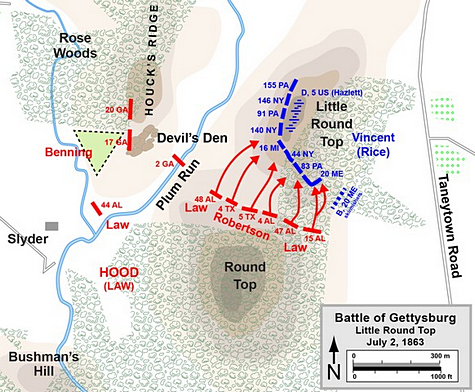
|
| Final Assault at Battle of Little Round Top |
| Little Round Top |
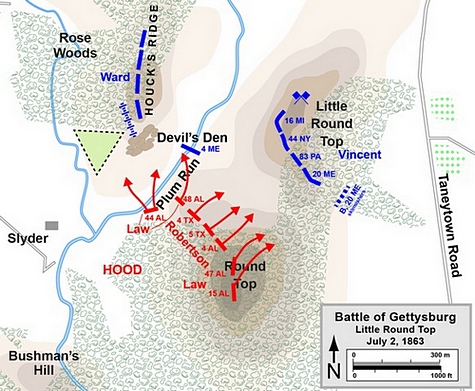
|
| Initial Assault at Battle of Little Round Top |
| 140th NY Monument |
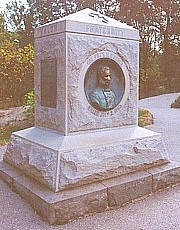
|
| Gettysburg NMP |
The swift attack of the New Yorkers stalled the last southern drive
on Little Round Top and the Confederates withdrew to the woods at the base of Big Round Top. O'Rorke's lifeless body was pried
out from the boulders and carried to a Union field hospital. Wounded Confederates scattered around the hillside pitifully
cried for water and several were rescued before Southern skirmishers opened fire on the Federals, which put a stop to their
efforts. The troops quickly threw up stone walls and took cover behind boulders as Confederate marksmen plied their trade
from positions in Devil's Den and the "Slaughter Pen". One victim of a southern sharpshooter was Brig. General Stephen Weed.
The stone walls and barricades built by members of Vincent's and Weed's brigade
still line Little Round Top today, behind which stand the monuments to the defenders of the hill. The 140th New York Infantry
is also represented with a monument bearing the likeness of the young Irish colonel who led the regiment that day and stands
near the location where he was killed. While the battle raged on the slopes of Little Round Top, Confederate troops swarmed
through the boulder-strewn pastures around Devil's Den, the left flank of General Sickles' battle line.
Sources: National Park Service; Gettysburg National Military Park; Civil
War Trust.
Recommended Reading: Twilight at Little Round Top: July 2, 1863, The Tide Turns
at Gettysburg (Hardcover). Description: "Few military episodes of the Civil War have attracted as much
attention as the struggle for Little Round Top on the second day of Gettysburg.
This judicious and engaging book navigates confidently through a welter of contradictory testimony to present a splendid account
of the action. It also places events on Little Round Top, which often are exaggerated, within the broader sweep of the battle.
All readers interested in the battle of Gettysburg will read
this book with enjoyment and profit." —Gary W. Gallagher, author of The Confederate War. "Here is the real story of
the epic fight for Little Round Top, shorn of the mythology long obscuring this pivotal Gettysburg
moment. A vivid and eloquent book." —Stephen W. Sears, author of Gettysburg.
Continued below…
"In his beautifully
written narrative, Glenn LaFantasie tells the story of the battle for Little Round Top from the perspective of the soldiers
who fought and died in July 1863. Using well-chosen quotes from a wide variety of battle participants, TWILIGHT puts the reader
in the midst of the fight—firing from behind boulders with members of the 4th Alabama, running up the hillside into battle with the men of the 140th New York, and watching in horror as far too many men die. This book offers an elegy to the
courage of those men, a meditation on the meaning of war, and a cautionary tale about the sacrifices nations ask of their
soldiers and the causes for which those sacrifices are needed." --Amy Kinsel, Winner of the 1993 Allan Nevins Prize for From
These Honored Dead: Gettysburg in American Culture
"Little Round
Top has become iconic in Civil War literature and American memory. In the emotional recollection of our great war, if there
was one speck on the landscape that decided a battle and the future of a nation, then surely this was it. The story of the
July 2, 1863 struggle for that hill outside Gettysburg goes
deeper into our consciousness than that, however. The men who fought for it then and there believed it to be decisive, and
that is why they died for it. Glenn W. LaFantasie's TWILIGHT AT LITTLE ROUND TOP addresses that epic struggle, how those warriors
felt then and later, and their physical and emotional attachment to a piece of ground that linked them forever with their
nation's fate. This is military and social history at its finest." --William C. Davis, author of Lincoln's Men and An Honorable Defeat.
Recommended Reading: Gettysburg--The Second Day, by Harry W. Pfanz (624 pages).
Description: The second day's fighting at Gettysburg—the assault of the Army of Northern Virginia against the Army of the Potomac
on 2 July 1863—was probably the critical engagement of that decisive battle and, therefore, among the most significant
actions of the Civil War. Harry Pfanz, a former historian at Gettysburg
National Military Park,
has written a definitive account of the second day's brutal combat. He begins by introducing the men and units that were to
do battle, analyzing the strategic intentions of Lee and Meade as commanders of the opposing armies, and describing the concentration
of forces in the area around Gettysburg. Continued below...
He then examines
the development of tactical plans and the deployment of troops for the approaching battle. But the emphasis is on the fighting
itself. Pfanz provides a thorough account of the Confederates' smashing assaults—at Devil's Den and Little Round Top,
through the Wheatfield and the Peach Orchard, and against the Union center at Cemetery Ridge. He also details the Union defense
that eventually succeeded in beating back these assaults, depriving Lee's gallant army of victory. Pfanz analyzes decisions
and events that have sparked debate for more than a century. In particular he discusses factors underlying the Meade-Sickles
controversy and the questions about Longstreet's delay in attacking the Union left. The narrative is also enhanced by thirteen superb maps, more than eighty illustrations,
brief portraits of the leading commanders, and observations on artillery, weapons, and tactics that will be of help even to
knowledgeable readers. Gettysburg—The Second Day
is certain to become a Civil War classic. What makes the work so authoritative is Pfanz's mastery of the Gettysburg literature and his unparalleled knowledge of the ground on which the fighting
occurred. His sources include the Official Records, regimental histories and personal reminiscences from soldiers North and
South, personal papers and diaries, newspaper files, and last—but assuredly not least—the Gettysburg battlefield.
Pfanz's career in the National Park Service included a ten-year assignment as a park historian at Gettysburg. Without doubt, he knows the terrain of the battle as well as he knows the battle
itself.
Recommended
Reading:
Through Blood and Fire at Gettysburg, by Joshua Lawrence Chamberlain.
Description: This book is based on the actual report written by Joshua Chamberlain after the Battle of Gettysburg. It is full
of photos and maps which help to clarify all positions and movements on the battlefield. Chamberlain's account is full of
excellent insight and illustrations…
Recommended
Reading:
"Bayonet! Forward": My Civil War Reminiscences, by Joshua Lawrence Chamberlain (Hardcover). Description: If you want
to learn more about Joshua L. Chamberlain, what better way to do it than to read his first hand accounts and speeches. This
book is a compilation of several articles he wrote for a magazine and a number of speeches he gave after the war. Bear in
mind that the magazine articles were heavily edited by the editor of the magazine, much to the chagrin of Chamberlain, who
was quite angry! One of his speeches at the dedication of the Gettysburg
monuments very succinctly outlines his reasons for volunteering for the Union Army and the ideology that kept him going back
to the field, even after a horrible wound that should have killed him. Continued below...
Chamberlain
wrote very eloquently about his experiences and his speeches are extremely moving... A must read for the Civil War buff and
admirers of General Chamberlain!
Recommended Reading:
Courage on Little Round Top: A Historical Novel. Description: If you have read Michael Shaara's "The Killer Angels" and
Stephen Crane's "The Red Badge of Courage" you have an excellent basis to read and enjoy Thomas Eishen's novel that combines
some of the aspects of both. This book features Joshua Lawrence Chamberlain, a prominent character in Shaara's novel, and
Lt. Robert Wicker, who is only alluded to by Shaara. Eishen's novel unfolds around the impending confrontation between these
two men on July 2, 1863, on Little Round Top during the Battle of Gettysburg. Wicker, whose unit is the 15th Alabama, had fled the scene during a previous battle, and, like Private Henry Fleming in
"The Red Badge of Courage," worries that he in fact may be a coward. Continued below...
Since
many of the soldiers in his company are friends and relatives from back home in Alabama, his fear is that a repeat performance in battle
will make him a laughingstock and he will become an embarrassment to his family and community. Chamberlain, on the other hand,
has to deal with his two well-intentioned but meddlesome brothers who are members of his staff. Eishen does a fine job of
relating the evolution of these events through dialogue fashioned for these characters. The run-up to the actual confrontation
between Chamberlain and Wicker is an interesting perspective on the daily lives of the common soldier in camp and while on
the march. First time novelist Thomas Eishen has done a commendable job of describing these fast-paced events, and readers
will find that the situation only alluded to in "The Killer Angels" takes on new meaning, and the characters involved come
alive.
Recommended
Reading: Stand Firm Ye Boys from Maine: The 20th Maine and the Gettysburg Campaign.
Description: The battle for the southern slope of Little Round Top at Gettysburg
on July 2, 1863, remains one of the most studied small unit military actions in American history. Maine
historian Tom Desjardin has focused his attention on the story of the 20th Maine Regiment since his first visit to Gettysburg at age 10. This stirring work is the culmination of years
of detailed research on the experiences of the soldiers in that regiment, telling the complete story of the unit in the Gettysburg
Campaign, from June 21 through July 10, 1863. Continued below...
Desjardin uses
more than seventy first-hand accounts of the battle to describe that fight in critical detail. He brings the personal experiences
of the soldiers to life, relating the story from both sides and revealing the actions and feelings of the men from Alabama
who tried, in vain, to seize the important position. From the lowest ranking private to the highest officers, this book explores
the terrible experiences and tragic effects of war. Following the regiment through the campaign enables readers to understand
fully the soldiers' feelings towards the enemy, towards citizens of both North and South, and towards the commanders of the
two armies. In addition, this book traces the development of a legend, as veterans of the fight struggle to remember, grasp,
and memorialize their part in the largest battle ever fought on the continent.
Recommended Reading: Gettysburg
Heroes: Perfect Soldiers, Hallowed Ground (Hardcover). Description: The Civil War generation saw its world in ways startlingly different from our own. In these essays,
Glenn W. LaFantasie examines the lives and experiences of several key personalities who gained fame during and after the war.
The battle of Gettysburg is the thread that ties these Civil
War lives together. Gettysburg was a personal turning point,
though each person was affected differently. Continued
below…
Largely biographical
in its approach, the book captures the human drama of the war and shows how this group of individuals--including Abraham Lincoln,
James Longstreet, Joshua Lawrence Chamberlain, William C. Oates, and others--endured or succumbed to the war and, willingly
or unwillingly, influenced its outcome. Concurrently, it shows how the war shaped the lives of these individuals, putting
them through ordeals they never dreamed they would face or survive.
Recommended Reading: Struggle for the Round
Tops: Law's Alabama Brigade at the Battle of Gettysburg. Description: Morris M. Penny and J. Gary Laine have produced a compelling
story of Law's Alabama Brigade's attempt to wrest the Round Tops from Federal hands. In July 1863, Evander McIver Law, age
26, was one of Robert E. Lee's most promising generals. His brigade of Alabamians shared the Army of Northern Virginia's sense
of invincibility. After a grueling 25-mile march to the battlefield, Law's men made a valiant three-hour effort to gain control
of the high ground on the Federal right. Continued below...
Struggle for the Round Tops describes
the vicious fighting around Devil's Den, in the Devil's Kitchen, and the heartbreaking repulse from Little Round Top. Law's
Alabamians participated in the defense of the Confederate right on July 3 and delighted in unhorsing a number of Federal troopers
in Farnsworth's charge. Two days after it arrived, the brigade retired from the field with the realization that the Federals
had matched their own fighting ability. Law himself departed with the seeds of discord planted that would ultimately culminate
in a devastating feud between himself and Longstreet. Much has been written about the conduct of the Confederate commanders
on July 2. Some historians have suggested that Law deliberately disobeyed an order to launch his assault up the Emmitsburg Road.
The authors examine the implications of Lee's orders and offer new insight into Hood's and Law's perspective of the situation
and the leeway Hood assumed as a division commander.

|

